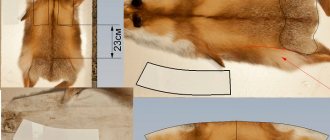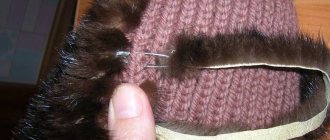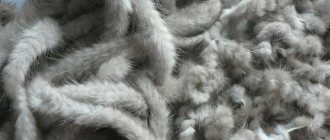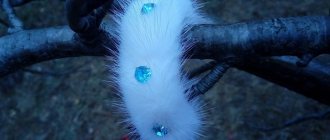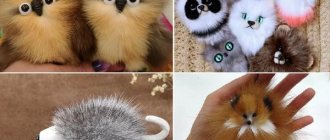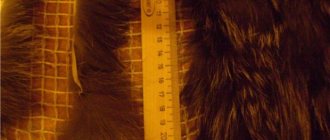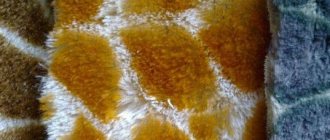Knitted fur hat: choosing fur and yarn
To knit a fur hat you will need:
- Fluffy natural fur, you can use it, but you should pay attention to the following criteria: the fur is dense, shiny, does not fray, the inner layer (the back side of the fur skin, the skin on which the hairs are held) is elastic, not dry, and does not crack. It is best to select skins where the flesh and fur are the same color or similar. For example, black fur, black or chocolate, or gray flesh. But if black fur has beige flesh, the work will be much harder;
- Yarn of medium thickness (about 160 m per 100 g of yarn), to match the flesh and fur, respectively. It will take about 100-150 g;
- Circular or toe knitting needles, 5 pcs. Please note that the recommended knitting needle numbers are always written on the yarn packaging. You need to choose the highest value so that the hat turns out loose.
And a few more tips on choosing fur. It is best to choose long fur, as long strips will be required. Ideally, it will be one piece, but if this is not the case, you can sew fur strips together, sewing one to the other until you get the required length. For those who have quality fur but it's short, don't worry, we have an idea for you too!
The fur can be either rabbit or arctic fox, nutria or astrakhan fur. But it must be dense and fluffy. The most beautiful hats are made from mink, raccoon and arctic fox fur.
Before cutting the strips, try this test:
- Rub the skin over a sheet of white paper. The fur should not fall off;
- Brush the fur with a round-tipped comb in the direction the fur grows. It is acceptable for a little lint to remain on the comb, but if the comb is clogged with undercoat, the fur will most likely fall off both during work and during wear;
- If the fur is used, see if it needs cleaning. If yes, clean it first, and only then start working with it.
Now regarding the yarn. It can be smooth and fluffy.
But you shouldn’t choose carefully, as it simply won’t be visible under thick fur. In this case, the yarn should be pleasant to the body, since it will directly adhere to the body.
Mink yarn on gimp thread
The method of preparing yarn on a frame thread is convenient and economical, but for this it is better to use mink or other fluffy fur. It is easier to wind fur strips onto the base thread, and less material is spent. During the process, you can monitor the thickness and density.
The yarn is created like this:
- You need to choose a warp thread of the same color as the fur;
- It is advisable to take fluffy fur;
- Fasten the thread and manually wind the mink strips onto it tightly;
- It is better to sew the wound strips to each other;
- The finished fur thread must be rolled into a ball.
It is better to use this thread for a denser product. Accessories will not seem so fluffy, but in the cold season, tight knitting is more relevant. And although you can take any skin, this season it is worth paying attention to mink.
Crocheted fur hat: master class with photos
In this section we will tell you how to make a crochet knitted fur hat. To work, we will need a thin hook, a thin thread in the color of the flesh and fur, as well as strips of fur, which we will now tell you how to cut correctly.
- So, you cannot cut fur with scissors, as you will ruin it. On the contrary, it is best to cut fur with a stationery knife, as well as with a regular T-shaped razor blade (as in the USSR).
This is what cut strips of fur look like
- We take a skin, a collar or a piece of fur and see where the fur goes. This is the fur growth line. In this master class we cut perpendicular to the growth line. This way, we will get uniform stripes, and subsequently they will look as natural as possible. The photo shows how the collar is cut. We cut the strips into a thickness of 1-1.5 cm. If you wish, you can experiment with the width of the strips, but not thinner than 1 cm.
Cutting the fur
- Now we sew all the strips together to make a single long strip. Pay attention to the color rendition around the edges. It is best to sew in the same order as the strip is cut.
- That is, we sew the bottom strip to the next top one, while we sew all the strips along the right edge (you can also sew along the left, it’s not important, but it’s important that it’s always on the same side). This way your fur will be dense and the shade will fit perfectly, and the seam will be invisible.
- The fur must be sewn using a furrier's stitch. Since this master class is for amateurs and you may not have a professional machine, therefore, it is worth mastering hand stitching. Watch a short video in which the master will show you this simple but durable seam.
For this work, it is best to use strong threads, as they can break under tension.
Rectangle fabric beanie
Now that you know how to take measurements and make a pattern, we’ll get to the point: the tailoring itself.
- Take a piece of fabric 55 cm high and OG wide (head circumference).
- Fold the front side inward. Matching the edges.
- We fasten with needles. Leave a small hole unattached (mark the boundaries with a pencil).
- We put a line where we connected with pins.
- The result is a pipe (conditionally).
- Combine one upper corner with the opposite one. The second one is exactly the same. There were 4 layers in total.
- We remove the second and third layers inside the structure. Connect the bottom layer with the top one. We pin it with pins.
- We lay a line along this place. But start stitching about 3 fingers away from the edge.
- But we don’t complete the stitching, but straighten the second and third layers and align the edges. We flash them the same way.
- We finish the line where we started.
- We look for a hole and turn the structure inside out. We straighten the cap.
- All that remains is to sew up this hole. We straighten the cap.
The Beanie hat is ready, wear it with pleasure. This model is quite simple, easy to sew.
Video: Do-it-yourself furrier stitch without a furrier machine
When we have a fur blank, we start knitting. We make a magic amigurumi ring and knit 6 single crochets in it. Tighten the ring and add a fur strip. Please note that we draw the hook as close to the flesh as possible, thereby spreading the down.
So, the knitting pattern:
- 1st row – crocheted amigurumi ring;
- 1 row – 6 single crochets;
- 3rd row - with a fur strip. 12 loops (each loop has 2 single crochets);
- 4th row – without fur. Double the columns through the loop. 2 single crochets with 2 loops, 1 column, and again 2 columns with 1 loop, etc.;
- 5th row - with a fur strip. Now double through 2 loops;
- Row 6 - without fur. Double through 3 loops.
We knit the bottom of a fur hat
- So we knit the bottom. You will get an even circle. The perimeter of this circle is equal to the volume of the head + 1 cm.
- For example, the volume of the head is 56 cm, which means we knit a circle until the volume is 57 cm. Sometimes it is difficult to achieve an equal value; the result is either 56 or 58 cm.
- Do not worry. In this case, knit 56 cm, and in the next row add 1-3 loops to reach a volume of 57 cm.
- In this case, additives should be proportionally distributed around the perimeter so that there are no “bumps”.
Finished bottom of a fur hat
- Next, knit without additives in single crochets, also alternating rows with and without fur. Having knitted the entire height of the hat, cut the strip and secure it.
- This is done like this: leave a thread tip of about 20 cm. Thread the thread into a gypsy needle and thread the tail of the strip. It is folded inward and sewn to the wrong side.
Ready-made crocheted fur hat
Now all that remains is to sew or knit, as you wish, the lining to the hat and sew it on. It is on the lining that a gap of 1 cm is given. But if the lining is planned to be silk, then 0.5 cm will be enough.
Women's hat for beginners
A simple hat model can be made elegant and fashionable if you use bright, high-quality yarn for knitting. To knit this hat you will need 100 g of thick yarn.
Process description:
- it is necessary to cast on an odd number of loops;
- knit 6 cm with a simple 2×2 elastic band;
- To knit a pattern you need an odd number of stitches. The pattern is obtained by knitting an elastic band by shifting due to an odd number of loops (1 row - edge loop, 2 knit loops, 2 purl loops, 2 row - one edge loop, 2 loops, 2 i.p.);
- for a voluminous hat, you will need to add one loop after the elastic every five loops, and then knit the pattern;
- for a tight-fitting hat, you need to finish knitting the hat after about 10 cm. For a voluminous hat - after about 15 cm. We begin to decrease the loops: we connect two loops together through two, we knit the second row according to the pattern, in the third row we knit two loops together through one, the fourth row knit according to the pattern, in the fifth we knit two loops together, in the sixth row we knit all the loops purl;
- remove the remaining loops and fasten them together.
Knitted fur hat: step by step
In this section we will tell you how to make a knitted fur hat with knitting needles. To work, you will need strips of fur (this time cut vertically along the growth line), yarn with a thickness of about 150-170 m per 100 g, knitting needles, a gypsy needle, and high-quality sewing thread No. 40. And also a piece of felt and suede. It is desirable that everything be the same color scheme.
So, let's get to work. The first thing we will do is knit the fabric. To start with the calculation:
- Cap volume = head volume + 1 cm;
- (Hat depth – 4 cm (bottom))*2 + = height of the knitted fabric.
If everything is clear about the volume, then we will analyze the second point in more detail. For example, we have a size 56 hat. In this case, look at the table, from which we understand that the standard depth of the header is 17.80; for simplicity, let’s round it up to 18.
So, (18-6)*2=24 cm.
Head measurement table for calculating headdress depth
It follows from this that we need to knit a cylindrical fabric without seams with a volume of 56 cm and a height of 24 cm. We knit with a 2*2 elastic band.
Knitted fabric with elastic band 2*2
- If you have a knitted fabric of the required size (an old jacket, hat, etc.), you can cut and overcast the edges on a machine.
Sewing edges on a sewing machine
- Now let's move on to cutting the skin. It can be moistened and stretched until completely dry. Next, you should make markings 14 cm in height and vertical stripes of 1-2 cm (this thickness corresponds to the width of two front loops on the canvas). Next, cut the strips using a knife or blade.
Skin marking
- Carefully cut the flesh, lifting the edges of the fur so as not to cut the hairs and not spoil the table. If you are cutting for the first time, do not rush, but do the work carefully.
Cutting fur strips
An important point: it is best not to cut 0.5 cm to the edge on one side. Thus, the fur on one side will be cut like an accordion, and on the other side it will be kept on a single sheet. This will make it easier to assemble the product.
This is what the cut strips look like
- Now we move on to the second fur, which is fluffier. We cut strips of 12 cm with the same thickness of the core. And let's move on to sewing.
Cutting the second fur
- You will need a blank, if you don’t have one, a bottle or a plastic 5-liter bottle, depending on the volume of the cap. The knitwear should be greatly stretched, this will make sewing easier.
We stretch the knitted fabric onto the blank
- As shown in the photo, we retreat 12 cm from the top and begin to sew the strips towards the bottom so that in the finished hat the pile faces down. Sew on two front loops, as shown in the photo. There will be about 40 stripes in total, but everything varies depending on the number of loops on the knitwear.
Sew on the stripes
- It is best to fasten the thread at the highest point and gradually sew strips in 0.5 cm increments. Stitches must be sewn first in one direction, then in the opposite direction. So that the fur fits tightly to the knitwear.
Sew on the second layer of stripes
- Now we move on to sewing the top strips. Their number coincides with the number of lower stripes.
Seam close up
This is what a hat blank with fur sewn on looks like
- Next we move on to creating the bottom. To do this, apply textile glue to the felt and carefully glue suede (can also be replaced with leather). Place a circle pattern 12 cm in diameter on top and outline it. Once everything has frozen, cut out a felt-suede circle.
Bonded felt with suede
- We turn the hat blank inside out so that all the fur is inside. We straighten the fur so that it does not peek out.
Turn the fur inside out
- Now we sew it to the edges of the hat as shown in the photo, so that the felt looks inward and the suede remains on the outside. Sew tightly, as shown in the photo.
Sew the bottom to the hat
- Next, we fold the wrong side of the knitwear - the lining, and also sew it to the bottom. If desired, the felt bottom can be covered with a circle of the same yarn and sewn to the lining.
Sew the lining to the bottom
- All that remains is to turn the hat inside out and comb it thoroughly.
Finished hat
How do you like these two options for knitted hats? Which one would you like to repeat?
And in conclusion, we’ll add another master class on how to make a knitted fur hat, where the stripes will be in a spiral, forming an interesting relief.
Step-by-step sewing of a hat
And now the fun part, we’re sewing a hat.
- Now you need to stitch along the darts.
- Fold them in half. It is important that the stitch ends at the point marked with chalk.
- We hide the tail from the overlog inside using a needle with a large eye and cut off the end. We do the same with the second side.
- Now you need to iron the edges.
- We smooth the seam in different directions (one allowance in one direction, the other in the other).
- The same goes for the grooves (one to the left, the other to the right).
- On the one hand, it is necessary to transfer the marks to the front side.
- Fold the hat in half, straighten the seam allowances in different directions, combine and pin with a needle.
- We do the same work with the slices: combine and chop.
- We will sew the line, focusing on the side marks. In order for the marks not to move, but to turn out symmetrically, they can be captured in this place with 1-2 stitches.
- We start the line on the overlog from this mark. When we reach a place where there are many layers and grooves, we need to manually turn the wheel. Just be careful not to break the needle.
- We hide the tails inside the line. Iron it well and turn the hat inside out.
- Straighten everything, iron it and make a lapel.
The knitted hat is ready. It is recommended to carry out wet-heat treatment so that it does not lose its shape.
Simple hat made from mink down with pearl pattern
Mink yarn is great for knitting berets for women. We will use regular pearl knitting.
Prepare: mink fluff yarn (350m/50g) – consumption approximately 100-125 grams (in 4 folds + 2 additional stitches); circular knitting needles No. 4.5 and No. 5.5.
Knitting pattern for a women's hat made of mink fluff:
On the sp. in a smaller size, cast on 82 stitches to the required fold number for the hat and 1 stitch to discreetly join into a circle. Knit 9 r. rubber band one on one. Change the size of the tool and make increases for volume: *purl, knit, increase purl. p., knits., purl., adding knits. p.* - and so on until the last loop in the row (= 123 p.). From the 11th to the 49th r. do the work with a pearl pattern (above the front stitch - purl stitch, over the back stitch - knit stitch). From 50th r. We begin to make decreases: * 3 sts (I, L, I) together purl, 1 knit*, – until the last 3 sts in the row, 3 vm. purl (=61 p.). 51 and 52 r - according to the drawing. 53 r.: *1 knits., 3 sts. purl* – to the end of p, at the end of knit 1 (= 31 p.). 54 and 55 rubles: according to the pattern. RUR 56: *3 vm. purl, knit 1*, at the end of 3 r. purl (=15 p.). 57 and 58 rubles: according to the drawing. RUR 59: *1 person, 3 vm. purl*, 2 p. purl. (=8 p.). To make a ponytail on the hat, switch to double needles. Divide the stitches onto two needles, 4 stitches each. and knit straight 3/4 r. (optional). Pull the loops and tuck in the ponytail.
Based on materials from @ziliko_vyazanie
Interesting: read a large collection of mohair hats here.
With one braid.
Video MK
Master class on knitting a downy hat with your own hands from mink with Aliexpress honeycomb pattern.
A charming option with small braids. Knitted hat in pumpkin style. Decorated with sequins - 33 pleasures. Children's hat hood with lining.
For the knitter: an incredibly beautiful and simple pattern. Delicate buds that can be used to knit a hat. Read more.
Knitting methods
On circular knitting needles
We cast on the required number of loops. Then there are two ways:
- We connect the product in a circle. We swap the two outer loops, threading one into the other. Next we go with the desired pattern.
- We knit the entire product with canvas and sew it together at the end. This path is relevant if the fabric is really large and does not fit on ordinary knitting needles.
In both cases, do not forget that you need to gradually decrease the loops closer to the top. Usually this is clearly stated in the diagrams.
Joining the initial row on circular knitting needles. Video tutorial:
Garter stitch
We cast on and start knitting in rows: slip off the first stitch and then knit all the way to the last one (it’s purl). Closer to the top, we remove the loops and finally sew the product together using a knitting needle.
In a circle it will be more practical - no need to sew + the hat will have no unnecessary irregularities.
Garter stitch in the round with knitting needles. Video for beginners:
Stockinette stitch
The only difference from the previous point is the structure.
We always remove the first one, always remove the last one. We knit the rows alternately: one - the whole rib, the second - sp.
As a result, you will get two sides - the wrong side and the front side, on which the given pattern is located.
How to knit smooth stockinette stitch - video tutorial:
Hat with 5 spokes
The knitting principle is similar to circular knitting needles. Divide the cast-on loops evenly into 4 parts and distribute them over the knitting needles. It turns out to be a square along which we continuously go upward with the fifth knitting needle in the desired knitting pattern.
Patterns for hats with knitting needles: diagrams and descriptions
English rubber band
This model is almost dimensionless. On average, we cast on 78 loops (for a simplified English rib, the formula for the number of loops cast on is 4n+2) on needles No. 4.
If desired, you can make an elastic headband from a 1 by 1 elastic band that can be tucked under. Otherwise, we make a headband with an elastic band 2 by 2 = 8 rows
We knit with an English elastic band: in the first row we make increases (= 95 sts).
A simplified version of the English gum:
- 3lp + ip - repeat;
- 2lp + ip + lp - repeat.
You can learn how to knit the classic version of the English rib using YouTube, but they look no different.
We knit upwards to make it 25 cm from the base. We begin to gradually decrease the singing, always knitting 3 together. In the first row, we take into account the outer edges, then ignore them and knit 3 along with the rest.
Finally, tighten the loops and sew the product along the seam. Keep in mind that you cannot tighten it too much, as the hat should turn out fluffy.
Stylish with braids
We cast on 94 sts and go (with knitting needles No. 4) with an elastic band (2 knits, 2 sp) about 6 cm. Move on to the braids:
- 2ip + 6lp + 2ip + 2lp - repeat;
- We knit according to the pattern, respectively, ip-ip and lp-lp.
On the 7th row of this knitting we make overlaps in a place with 6 lp. This can be done using toothpicks, alternately knitting the desired parts. Then we continue to follow the pattern 2ip + 2p + 2p and overlap again.
After the braids, we knit a row along the IS according to the pattern.
We perform the cycle described above only 3 times (3 overlaps are obtained).
Further - similarly, but decreasing to narrow it down.
Rubber band 2 by 2
We cast on the required number of loops and go in a circle to achieve the desired height of the hat:
- We knit the first sp under the second sp - the whole row;
- We knit 5 cm straight;
- (lp, sp, lp) - together + lp + sp + lp - the whole row;
- knit directly according to the pattern;
- 3lp-together + un - the whole row;
- ip under lp;
- insert the thread into the loose loops and tighten.
How to knit a hat for a girl?
A cat hat is an ideal option for a child.
Prepare the ears: cast on 17 loops and knit 4 rows in turn:
- lp;
- ip.
Next, we begin to remove the loop once in two rows on both sides.
The sharpness of the ears can be adjusted - it depends on the moment of the end.
The hat model can be almost anything - it all depends on your creativity. The main point is to form groups of wedges when we begin to decrease the loops. Their number should be even (usually 6) so that it is clear where to sew the ears.
How to knit a good hat
Different methods of knitting clothes leave their mark on the finished product. And if fluffy fur is more suitable for one method, for another it is better to take denser material. But hats made of mink yarn look great in any version.
Although old fur is suitable for knitting hats, mink skin that is too worn is unlikely to look attractive.
Try not to use low-quality material; the hairs on one strip should be the same length and thickness. The old fur should first be cleaned, and if it has faded, it should be painted.
A variety of hat models allows you to create any hats with your own hands. But you need to remember that dark-haired girls are more suited to noble brown shades of fur. Blonde fashionistas can experiment with gray and cream tones.
Clothing knitted by yourself is different in that you have the right to combine any colors and add decor at your discretion. A fur hat can be knitted from two colors; it is also not prohibited to combine cropped stripes and long-haired ones.
One layer for off-season
The hat was designed by the author Ekaterina (katika_handmade), for which many thanks to her. Make the work using thread in 3 folds + 2 stabilizing stitches. and circular knitting needles No. 5 and stocking needles No. 4.5. Cast on 76 stitches plus 1 connecting stitch, combine into a ring and knit 28 cm. Divide into four sectors of 19 stitches each and begin making the crown. To do this, before and after the marker, make decreases with an inclination towards the marked point. That is, in each decrease row. knitted fabric is decreased by 8 p. Perform such manipulations every second p. When there are few stitches left, it is more convenient to continue knitting on stocking stitches. We continue until there are 12 stitches left. We transfer them to the cut yarn and tighten them.
